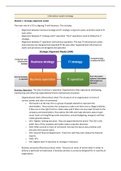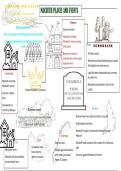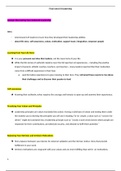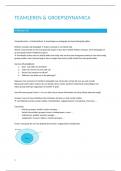Information system strategy
Module 1: Strategic alignment model
The main role of a CIO is aligning IT with business. This includes:
- Alignment between business strategy and IT strategy: Long-term plans, priorities need to fit
each other.
- Alignment between IT strategy and IT operation: The IT operations need to follow the IT
strategy.
- Alignment between IT operation and business operation: The way IT infrastructure assets
and processes are designed and operated fit the way other organizational infrastructure
assets and processes are designed and operated.
Business Operation: The way a business is operated. Organizations often operate by developing,
maintaining and enforcing organizational charts and business processes.
- Organizational charts (Hierarchical view): The structure of an organization in terms of
control, power and chain of commands.
o The board is at the top, this is a group of people elected to represent the
shareholders. They monitor the company to make sure there are no illegal activities,
if they are on the right track to create value and if there are any major threats to the
company and shareholders. They advise the CEO and make decisions about major
issues (such as hiring/firing senior executives, annual budgeting, mergers) and they
create general policies.
o CEO: Highest ranking executive. They are appointed by the board. The CEO is the
public face of the company and makes major corporate decisions.
o COO: Often second in chain of command. Oversee the day-to-day activities and
executes the business plans.
o CFO: Head of financial department. Tracks the cash flow and creates the financial
reports.
o CMO: 4P’s
o CIO: Highest level IT executive or manager in business.
- Business processes (Business process view): Focusses on series of action taken in order to
achieve a particular end (process). A business process is a process designed for or used by an
organization.
,IT operation: IT operations deals with the way IT is used and operated in a company. An information
system (IS) refers to a system that facilitates gathering, processing, storing, using information. This
can be paper-based or totally automated by computers. An information technology (IT) refers to the
use of computers to implement information systems. The IT department operates by developing,
maintaining and enforcing the use of IT assets and IT management capabilities.
IT assets: valuable IT-related people or things. IT assets are:
- A business application is a computer program that users associated to an organization use to
perform different business activities (Canvas, Osiris). Users interact with these business
applications through the user interface. There are many types:
Roles in a IT process are either completed by business applications or by users. The actions taken are
like showing an interface or storing something in a database.
- Business applications store, process and disseminate data. This data are usually stored in an
organized way. A typical database includes several related tables. A table has several
columns at the beginning. Business applications modify tables by adding, updating or
deleting rows over time.
- Users are the people (employee, customer or supplier) that have access to business
applications and use them to perform organizational tasks.
- IT infrastructure contains a set of components that support business applications and IT
service.
- IT staff are the employees who carry out different tasks in the IT department.
IT management capabilities are capabilities related to adding, maintaining, removing, and using IT
assets effectively and efficiently. Consists of:
- IT management process: Process that deals with adding, maintaining, removing and using IT
assets. It is a business process under the supervision of the CIO.
- IT management organization: shows the IT management hierarchy (CTO, CISO, CDO)
,Business strategy: A strategy is a plan of action designed to achieve a long-term or overall goal. A
business strategy can be developed at three levels:
- Corporate
- Strategic Business Unit
- Functional: An IS strategy is a functional strategy and need to be aligned with strategic
business unit and corporate strategies.
For strategic positioning
there are two general
strategies (extremes).
Focus strategy: A
company can use one
generic strategy in one
market, and the other in
another market. In this
way they try to target a
niche market.
There are three types of firms that can be explained using strategy attributes:
(IS)/IT-strategy: It is the plan of action for IS and IT designed to achieve a long-term goal.
, To design an IS strategy, we usually design current and future ‘application portfolio’. An application
portfolio is the organization’s collection of business applications.
The business strategy identifies what new capabilities are required, which capabilities must be
improved and what capabilities are becoming obsolete. Afterwards the IS strategy identifies what
new applications are required, what new features should be added to the current applications and
what applications are becoming obsolete. IT strategy identifies what new IT assets are required and
what IT assets are becoming obsolete.
The IS and IT strategies require a project roadmap. This roadmap shows the prioritization of future IS
and IT projects following the upcoming years. There are three types of IS strategies:
Alignment types:
- Business alignment: The degree to which the higher level, externally focused business
strategies are aligned with the lower level, internally focused business infrastructure and
processes (COO)
- Strategic alignment: The degree business strategy supports and is supported by the IT
strategy (CIO)
- IT alignment: The degree to which the higher level, externally focused IT strategies re aligned
with the lower level, internally focused IT infrastructure and processes. Do the applications
fit the plan? (CIO)
- Operational alignment: The lower level, internally focused operational level of alignment
deals with how the business infrastructure and processes align with the IT infrastructure and
processes (CIO).
Strategic (intellectual) Alignment (between
business and IT strategy):
- Business Strategy – IT Governance
Alignment: To who should the CIO
report to? This depends on the strategic
positioning (differentiation or cost
leadership).
Module 1: Strategic alignment model
The main role of a CIO is aligning IT with business. This includes:
- Alignment between business strategy and IT strategy: Long-term plans, priorities need to fit
each other.
- Alignment between IT strategy and IT operation: The IT operations need to follow the IT
strategy.
- Alignment between IT operation and business operation: The way IT infrastructure assets
and processes are designed and operated fit the way other organizational infrastructure
assets and processes are designed and operated.
Business Operation: The way a business is operated. Organizations often operate by developing,
maintaining and enforcing organizational charts and business processes.
- Organizational charts (Hierarchical view): The structure of an organization in terms of
control, power and chain of commands.
o The board is at the top, this is a group of people elected to represent the
shareholders. They monitor the company to make sure there are no illegal activities,
if they are on the right track to create value and if there are any major threats to the
company and shareholders. They advise the CEO and make decisions about major
issues (such as hiring/firing senior executives, annual budgeting, mergers) and they
create general policies.
o CEO: Highest ranking executive. They are appointed by the board. The CEO is the
public face of the company and makes major corporate decisions.
o COO: Often second in chain of command. Oversee the day-to-day activities and
executes the business plans.
o CFO: Head of financial department. Tracks the cash flow and creates the financial
reports.
o CMO: 4P’s
o CIO: Highest level IT executive or manager in business.
- Business processes (Business process view): Focusses on series of action taken in order to
achieve a particular end (process). A business process is a process designed for or used by an
organization.
,IT operation: IT operations deals with the way IT is used and operated in a company. An information
system (IS) refers to a system that facilitates gathering, processing, storing, using information. This
can be paper-based or totally automated by computers. An information technology (IT) refers to the
use of computers to implement information systems. The IT department operates by developing,
maintaining and enforcing the use of IT assets and IT management capabilities.
IT assets: valuable IT-related people or things. IT assets are:
- A business application is a computer program that users associated to an organization use to
perform different business activities (Canvas, Osiris). Users interact with these business
applications through the user interface. There are many types:
Roles in a IT process are either completed by business applications or by users. The actions taken are
like showing an interface or storing something in a database.
- Business applications store, process and disseminate data. This data are usually stored in an
organized way. A typical database includes several related tables. A table has several
columns at the beginning. Business applications modify tables by adding, updating or
deleting rows over time.
- Users are the people (employee, customer or supplier) that have access to business
applications and use them to perform organizational tasks.
- IT infrastructure contains a set of components that support business applications and IT
service.
- IT staff are the employees who carry out different tasks in the IT department.
IT management capabilities are capabilities related to adding, maintaining, removing, and using IT
assets effectively and efficiently. Consists of:
- IT management process: Process that deals with adding, maintaining, removing and using IT
assets. It is a business process under the supervision of the CIO.
- IT management organization: shows the IT management hierarchy (CTO, CISO, CDO)
,Business strategy: A strategy is a plan of action designed to achieve a long-term or overall goal. A
business strategy can be developed at three levels:
- Corporate
- Strategic Business Unit
- Functional: An IS strategy is a functional strategy and need to be aligned with strategic
business unit and corporate strategies.
For strategic positioning
there are two general
strategies (extremes).
Focus strategy: A
company can use one
generic strategy in one
market, and the other in
another market. In this
way they try to target a
niche market.
There are three types of firms that can be explained using strategy attributes:
(IS)/IT-strategy: It is the plan of action for IS and IT designed to achieve a long-term goal.
, To design an IS strategy, we usually design current and future ‘application portfolio’. An application
portfolio is the organization’s collection of business applications.
The business strategy identifies what new capabilities are required, which capabilities must be
improved and what capabilities are becoming obsolete. Afterwards the IS strategy identifies what
new applications are required, what new features should be added to the current applications and
what applications are becoming obsolete. IT strategy identifies what new IT assets are required and
what IT assets are becoming obsolete.
The IS and IT strategies require a project roadmap. This roadmap shows the prioritization of future IS
and IT projects following the upcoming years. There are three types of IS strategies:
Alignment types:
- Business alignment: The degree to which the higher level, externally focused business
strategies are aligned with the lower level, internally focused business infrastructure and
processes (COO)
- Strategic alignment: The degree business strategy supports and is supported by the IT
strategy (CIO)
- IT alignment: The degree to which the higher level, externally focused IT strategies re aligned
with the lower level, internally focused IT infrastructure and processes. Do the applications
fit the plan? (CIO)
- Operational alignment: The lower level, internally focused operational level of alignment
deals with how the business infrastructure and processes align with the IT infrastructure and
processes (CIO).
Strategic (intellectual) Alignment (between
business and IT strategy):
- Business Strategy – IT Governance
Alignment: To who should the CIO
report to? This depends on the strategic
positioning (differentiation or cost
leadership).






